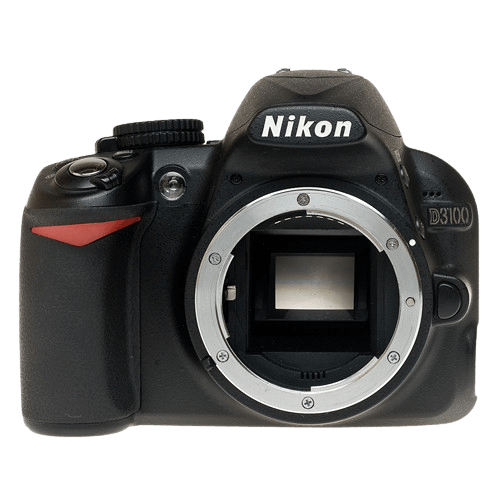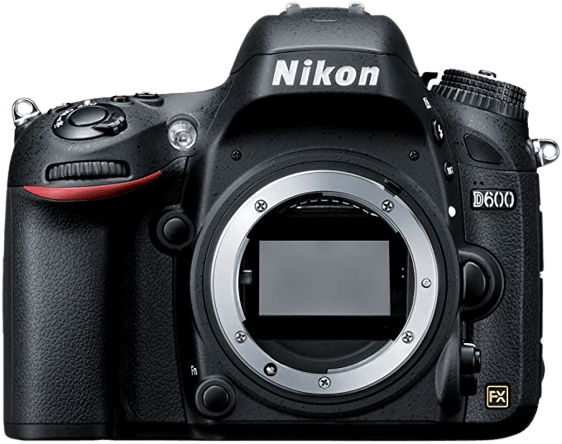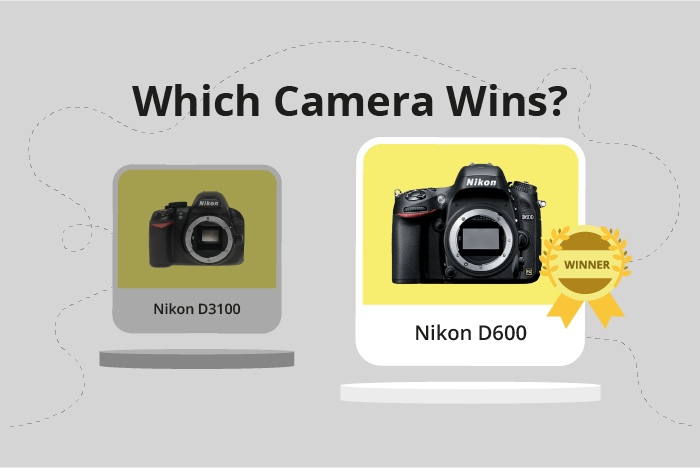Nikon D3100 vs D600 Comparison
Nikon D3100

Nikon D600

The Nikon D600 emerges as the clear winner with a score of 66/100, while the Nikon D3100 trails behind at 41/100. Both cameras are DSLRs and were released in 2010 and 2012, respectively. They share similarities in being DSLRs and having similar camera sizes, with the D3100 measuring 124 x 96 x 75mm and the D600 at 141 x 113 x 82mm.
The D600 outshines the D3100 with its higher score, indicating a better overall performance. However, the D3100 has its advantages, such as being lighter at 505g compared to the D600’s 850g and having a more affordable launch price of $699 compared to the D600’s $2100.
Taking into account the scores, specifications, and prices, the Nikon D600 is the superior camera, but the Nikon D3100 may be a more suitable option for those prioritizing weight and affordability.
Nikon D3100 vs D600 Overview and Optics
The Nikon D600 outperforms the Nikon D3100 in optics, scoring 70/100 compared to the D3100’s 41/100. Both cameras share some common specifications, such as the CMOS sensor type, Nikon F lens mount, and the absence of image stabilization. However, the D600 surpasses the D3100 in several aspects, making it the superior choice for those prioritizing optical performance.
The D600 boasts a higher megapixel count at 24.3 compared to the D3100’s 14.8, providing greater detail and resolution in images. It also has a faster shooting speed of 5.5 frames per second, allowing for better capture of fast-moving subjects or action shots. The D600 is equipped with the Expeed 3 processor, an upgrade from the D3100’s Expeed 2, resulting in improved image processing and overall performance. Furthermore, the D600 has a higher DXOMARK sensor score of 94, indicating better image quality, dynamic range, and low-light performance. Additionally, the D600 features a full-frame sensor, which offers a larger sensor size than the D3100’s APS-C sensor, contributing to enhanced image quality and better low-light performance.
While the D3100 does not surpass the D600 in any specific optical aspect, it still provides decent image quality and performance for its class, making it a suitable option for beginners or those on a tighter budget.
Given these points, the Nikon D600 emerges as the clear winner in terms of optical performance. Its higher megapixel count, faster shooting speed, upgraded processor, superior sensor score, and full-frame sensor size all contribute to its advantage over the Nikon D3100. However, the D3100 remains a viable option for those seeking a more budget-friendly camera with acceptable performance.
Nikon D3100 vs D600 Video Performance
When comparing the video capabilities of the Nikon D3100 and the Nikon D600, it is important to note that the Nikon D3100 does not have any video functionality. This means that if video recording is a priority for you, the Nikon D3100 may not be the best choice.
On the other hand, the Nikon D600 has a video score of 57 out of 100, offering Full HD video recording with a maximum resolution of 1920 x 1080. This camera can record video at a frame rate of up to 30fps, providing smooth and detailed footage. Additionally, the Nikon D600 has built-in time-lapse functionality, allowing for creative video options and features.
Given this information, it is clear that the Nikon D600 is the better choice for those who require video capabilities in their camera. While the Nikon D3100 lacks video functionality, the Nikon D600 offers Full HD video recording, a high frame rate, and time-lapse features, making it a more versatile and well-rounded option.
Nikon D3100 vs D600 Features and Benefits
The Nikon D600 emerges as the winner with a feature score of 57/100, compared to the Nikon D3100’s score of 36/100. Both cameras share some common specifications, such as the lack of a touchscreen, flip screen, GPS, and Bluetooth. However, the D600 outshines the D3100 in certain aspects, while the D3100 has minimal advantages over the D600.
The D600’s superior features include a larger screen size of 3.2 inches, compared to the D3100’s 3-inch screen. The screen resolution on the D600 is significantly higher at 921,000 dots, providing better image preview and menu navigation. Furthermore, the D600 offers built-in WiFi connectivity, making it convenient to transfer images and control the camera remotely.
On the other hand, the D3100 does not have any notable advantages over the D600, given that both cameras lack a touchscreen, flip screen, GPS, and Bluetooth. The only advantage the D3100 holds is its lower price point, making it a more affordable option for beginner photographers.
Taking these points into consideration, the Nikon D600 is the clear winner in terms of features, providing a larger and higher-resolution screen as well as WiFi connectivity. The Nikon D3100 does not present any significant advantages, other than being a more budget-friendly option. Therefore, photographers seeking better features and improved usability should opt for the Nikon D600, while those looking for a more affordable option may consider the Nikon D3100.
Nikon D3100 vs D600 Storage and Battery
The Nikon D600 outperforms the Nikon D3100 in storage and battery, with a score of 71/100 compared to the D3100’s 53/100. Both cameras have compatibility with SD, SDHC, and SDXC memory cards. However, the D600 has two memory card slots, while the D3100 has only one, providing more storage flexibility for the D600.
In terms of battery life, the D3100 surprisingly has a longer life with 4,500 shots per charge, whereas the D600 offers 900 shots. The D3100 uses an EN-EL14 battery, while the D600 uses an EN-EL15 battery. Neither camera has USB charging capabilities.
Despite the D3100’s superior battery life, the D600 still prevails in overall storage and battery performance due to its dual memory card slots. The D3100’s longer battery life, though noteworthy, does not compensate for its lack of storage flexibility.
Nikon D3100 vs D600 – Our Verdict
Are you still undecided about which camera is right for you? Have a look at these popular comparisons that feature the Nikon D3100 or the Nikon D600:

